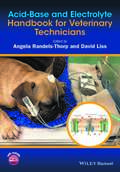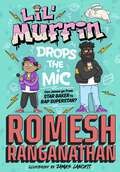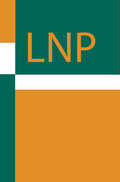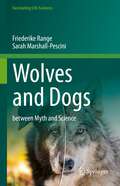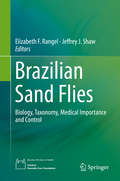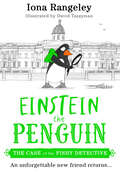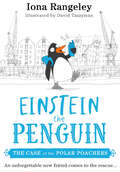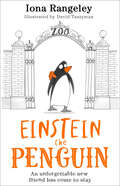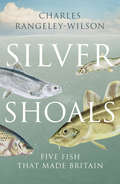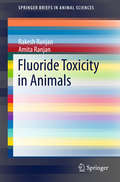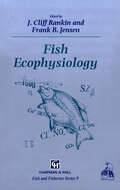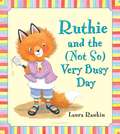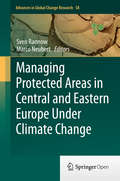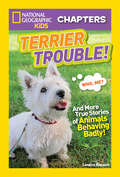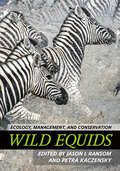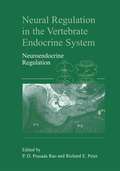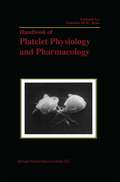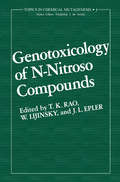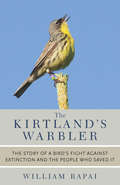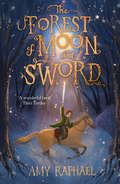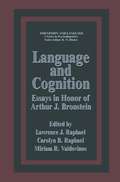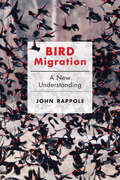- Table View
- List View
Acid-Base and Electrolyte Handbook for Veterinary Technicians
by Angela Randels 8208 Thorp David LissAcid-Base and Electrolyte Handbook for Veterinary Technicians provides an easy to understand yet comprehensive approach to acid-base and electrolyte balance. Covers the physiology of fluids and their effect on acid-base and electrolyte balance Offers detailed information on managing acid-base and electrolyte derangements in disease Includes access to a companion website with case studies and multiple choice questions
Acid-Base and Electrolyte Handbook for Veterinary Technicians
by Angela Randels-Thorp David LissAcid-Base and Electrolyte Handbook for Veterinary Technicians provides an easy to understand yet comprehensive approach to acid-base and electrolyte balance. Covers the physiology of fluids and their effect on acid-base and electrolyte balance Offers detailed information on managing acid-base and electrolyte derangements in disease Includes access to a companion website with case studies and multiple choice questions
Lil' Muffin Drops the Mic: The brand-new children’s book from comedian Romesh Ranganathan!
by Romesh RanganathanFrom comedy superstar Romesh Ranganathan comes a hilarious and heartfelt tale that proves rap battles and baking muffins really can mix. The perfect story for readers age 8+ and fans of David Baddiel and Adam B Wins the Internet!Ever since his dad left, James can't seem to stop worrying about everything. His favourite hobby, baking, is a fun (and delicious!) distraction, but no matter how many AMAZING brownies he makes, James still feels like there's a missing ingredient in his life . . .Until he discovers rapping, and he's COMPLETELY hooked. It's not long before James starts writing his own raps about everything - from music and cakes to his giant pet rabbit, Graham!So when he hears that grime artist star Brukka is on the hunt for young talent, James starts to wonder: could this be his chance to share his MUFFINS, his MUSIC, and maybe even his feelings with the whole school? If he could only find the confidence . . .Full of laugh-out-loud illustrations from bestselling illustrator James Lancett, this is the children's read of the summer!
Processes with Long-Range Correlations: Theory and Applications (Lecture Notes in Physics #621)
by Govindan Rangarajan Mingzhou DingProcesses with long range correlations occur in a wide variety of fields ranging from physics and biology to economics and finance. This book, suitable for both graduate students and specialists, brings the reader up to date on this rapidly developing field. A distinguished group of experts have been brought together to provide a comprehensive and well-balanced account of basic notions and recent developments. The book is divided into two parts. The first part deals with theoretical developments in the area. The second part comprises chapters dealing primarily with three major areas of application: anomalous diffusion, economics and finance, and biology (especially neuroscience).
Wolves and Dogs: between Myth and Science (Fascinating Life Sciences)
by Friederike Range Sarah Marshall-PesciniVarious parallels have been drawn between wolves and humans from the perspective of their social organisation. Therefore, studying wolves may well shed light on the evolutionary origins of complex human cognition and, in particular, on the role that cooperation played in its development. Humans closely share their lives with millions of dogs – the domesticated form of wolves. Biologically, wolves and dogs can be considered to be the same species; yet only dogs are suitable living companions in human homes, highlighting the importance of cognitive and emotional differences between the two forms. The behaviour of wolves and dogs largely depends on the environment the animals grew up and live in. This book reviews more than 50 years of research on the differences and similarities of wolves and dogs. Beyond the socio-ecology, the work explores different theories about when and how the domestication of wolves might have started and which behaviours and cognitive abilities might have changed during this process. Readers will discover how these fascinating animals live with their conspecifics in their social groups, how they approach and solve problems in their daily lives and how they see and interact with their human partners.
Brazilian Sand Flies: Biology, Taxonomy, Medical Importance and Control
by Elizabeth F. Rangel Jeffrey J. ShawThis is the first English-language book dedicated to Brazilian sand flies and their medical importance. No other country has so many species of these haematophagous insects as Brazil and their diversity has reached an astonishing level. The book contains comprehensive chapters, written by Brazilian experts on their regional distribution, their ecology and their importance as vectors of pathogens and parasites. Methods for sampling, processing and preserving phlebotomines are reviewed as are perspectives on surveillance and leishmaniasis vector control. A novel classification is presented whose aim is to help investigators identify the species that they are working with more efficiently.
The Case of the Fishy Detective (Einstein the Penguin #2)
by Iona RangeleyAn unforgettable friend returns in this warm and fantastically funny sequel to the bestselling debut Einstein the Penguin.
The Case of the Polar Poachers (Einstein the Penguin #3)
by Iona RangeleyEinstein the penguin is back in this future-classic and fantastically funny story for all the family to enjoy. Get ready to welcome the most extraordinary penguin back into your own home.
Einstein the Penguin
by Iona RangeleyPerfect for all readers from 7 to 70, Einstein the Penguin introduces an unforgettable new character in a future-classic and fantastically funny debut for all the family to enjoy. Get ready to welcome the most extraordinary penguin into your own home…
Silver Shoals: Five Fish That Made Britain
by Charles Rangeley-WilsonOn these rain-swept islands in the North Atlantic man and fish go back a long way. Fish are woven through the fabric of the country’s history: we depend on them – for food, for livelihood and for fun – and now their fate depends on us in a relationship which has become more complex, passionate and precarious in the sophisticated 21st Century.In Silver Shoals Charles Rangeley-Wilson travels north, south, east and west through the British Isles tracing the histories, living and past, of our most iconic fish – cod, carp, eels, salmon and herring – and of the fishermen who catch them and care for them. In the company of trawlermen, longshoremen, conservationists and anglers Charles goes to sea in a trawler, whiles away hot afternoons setting eel nets, tries to bag his first elusive carp and drifts for herring on Guy Fawkes night as fireworks starburst the sky. Underscoring this journey is a fascinating historical exploration of these creatures that have shaped our island story. We learn how abundant and valued these fish were centuries before our current crisis of over-fishing: we learn how eels built our monasteries, how cod sank the Spanish Armada, how fish and chips helped us through two World Wars. Of course there is a deeper environmental dimension to the story, but Charles' optimistic perspective is this: no one is more invested in fish than the fishermen whose lives depend on them. If we can find a way to harness that passion then the future of fish and fishermen in Britain could be as extraordinary as its past.
Fluoride Toxicity in Animals (SpringerBriefs in Animal Sciences)
by Rakesh Ranjan Amita RanjanThis book describes in detail various aspects of fluoride toxicity in animals. Animals, like human beings, suffer from the toxic effects of excess fluoride intake. They show pathological changes in their teeth and bone, together with a marked reduction in appetite, productive and reproductive potentials, which can result in severe economic losses in the dairy industry. Laboratory and wild animals also suffer from this ailment. Animal suffering and economic losses alike can be minimized through early diagnosis of the problem and by adopting suitable preventive and therapeutic measures. The book details the susceptibility of different animal species, important sources of toxicity, clinical signs and symptoms, pathophysiology, diagnostic methods, preventive and therapeutic approaches. It offers a valuable resource for scientists working in the fields of toxicology, veterinary science, animal nutrition, and environmental science, as well as for public health workers, animal welfare activists, public health veterinarians, field veterinarians, medical professionals and all others interested in the subject.
Fish Ecophysiology (Fish & Fisheries Series #9)
by J.C. Rankin Frank B. JensenAmong the fishes. a remarkably wide range of biological adaptations to diverse habitats has evolved. As well as living in the conventional habitats of lakes. ponds, rivers, rock pools and the open sea, fish have solved the problems of life in deserts. in the deep sea. in the cold antarctic. and in warm waters of high alkalinity or of low oxygen. Along with these adaptations, we find the most impressive specialisations of morphology, physiology and behaviour. For example we can marvel at the high-speed swimming of the marlins. sailfish and warm-blooded tunas, air-breathing in catfish and lungfish. parental care in the mouth-brooding cichlids and viviparity in many sharks and toothcarps. Moreover, fish are of considerable importance to the survival of the human species in the form of nutritious. delicious and diverse food. Rational exploi management of our global stocks of fishes must rely upon a detailed tation and and precise insight of their biology. The Chapman [.,. Hall Fish and Fisheries series aims to present timely volumes reviewing important aspects of fish biology. Most volumes will be of interest to research workers in biology. zoology. ecology and physiology but an additional aim is for the books to be accessible to a wide spectrum of non-specialist readers ranging from undergraduates and postgraduates to those with an interest in industrial and commercial aspects of IIsh and t1sheries.
Ruthie and the (Not So) Very Busy Day
by Laura RankinIt's Saturday morning-Ruthie's very favorite day. No school. No homework. No practices. Just a day to be with Mom and Dad. And Ruthie has BIG plans with her day off. But they keep getting interrupted. Dad has to go off to help Grandma. Mom has errands to run. Poor Ruthie is suddenly having the worst day ever! Will things ever look up? And can Ruthie manage to find any fun on her favorite day? Old and new fans alike will find much to love in this new Ruthie picture book, which stresses the importance of taking a break from the hustle and bustle to enjoy cozy family time.
Ruthie and the (Not So) Very Busy Day
by Laura RankinIt's Saturday morning-Ruthie's very favorite day. No school. No homework. No practices. Just a day to be with Mom and Dad. And Ruthie has BIG plans with her day off. But they keep getting interrupted. Dad has to go off to help Grandma. Mom has errands to run. Poor Ruthie is suddenly having the worst day ever! Will things ever look up? And can Ruthie manage to find any fun on her favorite day? Old and new fans alike will find much to love in this new Ruthie picture book, which stresses the importance of taking a break from the hustle and bustle to enjoy cozy family time.
Managing Protected Areas in Central and Eastern Europe Under Climate Change (Advances in Global Change Research #58)
by Sven Rannow Marco NeubertBeginning with an overview of data and concepts developed in the EU-project HABIT-CHANGE, this book addresses the need for sharing knowledge and experience in the field of biodiversity conservation and climate change. There is an urgent need to build capacity in protected areas to monitor, assess, manage and report the effects of climate change and their interaction with other pressures. The contributors identify barriers to the adaptation of conservation management, such as the mismatch between planning reality and the decision context at site level. Short and vivid descriptions of case studies, drawn from investigation areas all over Central and Eastern Europe, illustrate both the local impacts of climate change and their consequences for future management. These focus on ecosystems most vulnerable to changes in climatic conditions, including alpine areas, wetlands, forests, lowland grasslands and coastal areas. The case studies demonstrate the application of adaptation strategies in protected areas like National Parks, Biosphere Reserves and Natural Parks, and reflect the potential benefits as well as existing obstacles. A general section provides the necessary background information on climate trends and their effects on abiotic and biotic components. Often, the parties to policy change and conservation management, including managers, land users and stakeholders, lack both expertise and incentives to undertake adaptation activities. The authors recognise that achieving the needed changes in behavior – habit – is as much a social learning process as a matter of science-based procedure. They describe the implementation of modeling, impact assessment and monitoring of climate conditions, and show how the results can support efforts to increase stakeholder involvement in local adaptation strategies. The book concludes by pointing out the need for more work to communicate the cross-sectoral nature of biodiversity protection, the value of well-informed planning in the long-term process of adaptation, the definition of acceptable change, and the motivational value of exchanging experience and examples of good practice.
National Geographic Kids Chapters: And More True Stories Of Animals Behaving Badly (National Geographic Kids Chapters)
by Candice Ransom National Geographic KidsMeet a thieving emu, a devious cat, and a pesky pup in these hilarious tales about animals who love to play tricks, create chaos, and run a bit wild.
Wild Equids: Ecology, Management, and Conservation
by Jason I. Ransom Petra KaczenskyWild horses, zebras, asses, and feral equines exhibit intriguing and complex social structures that captivate the human imagination and elicit a wide range of emotions that influence conservation and management efforts. This book, spearheaded by Jason I. Ransom and Petra Kaczensky, brings together the world's leading experts on equid ecology, management, and conservation to provide a synthesis of what is known about these iconic species and what needs to be done to prevent losing some of them altogether. The most comprehensive conservation book on wild equids in decades, this title will enlighten not only equid researchers, but also mammalogists, conservationists, and equine professionals. Readers will find new insight into the lives of the world's horses, zebras, and asses, understand the basis of our relationships with these animals, and develop a greater understanding of where equids come from and why they are worth conserving.Included in this book are detailed, state-of-the-science syntheses on Social structure, behavior, and cognition Habitat and diet Ecological niches Population dynamics Roles of humans in horse distribution through time Human dimensions and the meaning of wild Management of free-roaming horses Captive breeding of wild equids Conservation of wild equids Conservation of migrations Reintroductions Genetics and paleogenetics
Wild Equids: Ecology, Management, and Conservation
by Jason I. Ransom Petra KaczenskyWild horses, zebras, asses, and feral equines exhibit intriguing and complex social structures that captivate the human imagination and elicit a wide range of emotions that influence conservation and management efforts. This book, spearheaded by Jason I. Ransom and Petra Kaczensky, brings together the world's leading experts on equid ecology, management, and conservation to provide a synthesis of what is known about these iconic species and what needs to be done to prevent losing some of them altogether. The most comprehensive conservation book on wild equids in decades, this title will enlighten not only equid researchers, but also mammalogists, conservationists, and equine professionals. Readers will find new insight into the lives of the world's horses, zebras, and asses, understand the basis of our relationships with these animals, and develop a greater understanding of where equids come from and why they are worth conserving.Included in this book are detailed, state-of-the-science syntheses on Social structure, behavior, and cognition Habitat and diet Ecological niches Population dynamics Roles of humans in horse distribution through time Human dimensions and the meaning of wild Management of free-roaming horses Captive breeding of wild equids Conservation of wild equids Conservation of migrations Reintroductions Genetics and paleogenetics
Neural Regulation in the Vertebrate Endocrine System: Neuroendocrine Regulation
by Dodla Sai Prasada Rao Richard E. PeterHandbook of Platelet Physiology and Pharmacology
by Gundu H. R. RaoThis is the first comprehensive work to review blood platelet biochemistry, physiology, pharmacology, and function. It provides up-to-date information on how platelets function, the biochemical mechanisms that modulate their physiology and function, as well as the pharmacology of platelet inhibitory drugs.
Genotoxicology of N-Nitroso Compounds (Topics in Chemical Mutagenesis)
by T. RaoToph's in Chemical Mutagenesis is a new series dedicated to studies in the areas of environmental chemical mutagenesis and genetic toxicology. In this series we will explore some of many topics that are emerging in these rapidly developing fields. The purpose of the present volume is to attempt to organize and compare the genotoxic properties of the N-nitroso compounds. This is a particularly interesting class of compounds because of the problems encountered with the Salmonella assay of Ames in generating both false positive and false negative results. The battery approach using a number of assay systems seems more appropriate to evaluate chemicals in this class. Topics to be discussed in other volumes in this series include single-cell mutation monitoring systems, the detection of genetic damage in mammalian germ cells, the mutagenicity of pesticides, problems in monitoring human populations in genetic toxicology, and a glossary of terms in genetic toxicology. All of these books are in various stages of development and should appear within the next few years. Frederick J. de Serres Series Editor vii Preface During the past ten years there has been an explosive development in the number of short-term tests to predict the biological risks, especially risks of cancer, in exposure to xenobiotic chemicals. The number of published articles in this area has reached many thousands a year and there are several new journals devoted almost entirely to the presentation of the results obtained in these tests.
The Kirtland's Warbler: The Story of a Bird's Fight Against Extinction and the People Who Saved It
by William RapaiThis book looks at the Kirtland’s warbler and wildlife conservation in a way that no other book has. It looks back on the history of this unique bird, examines the people and policies that kept the warbler from extinction, explores the cult of personality that surrounds it, and examines the challenges of the future—all through the eyes of the people who have acted so passionately on its behalf. The story of the Kirtland’s warbler is a story of complex relationships between the bird and its environment, the humans who interact with it, and the complex government policies that affect it. And now, just when it appears that the Kirtland’s warbler has recovered for good, a change in its status may send the warbler’s population into a downward spiral once again.
The Forest of Moon and Sword
by Amy Raphael'A wonderful book' PIERS TORDAY'Very exciting' ANTHONY MCGOWAN When Art's mother is accused of witchcraft and captured, she is determined to get her back - at any cost. A lyrical adventure with folklore at its heart, for fans of THE HOUSE WITH CHICKEN LEGS.Twelve-year-old Art lives in a small village in Scotland. Her mother has always made potions that cure the sick, but now the townspeople say she is a witch. One cloudless night, Art's mother is arrested and taken to England. Art mounts her horse, taking a sword, a tightrope, and a herbal recipe book, and begins a journey through wild forests, using nature's signs and symbols to guide her.But will she spot the signs from the omens? Will she reach her mother, before it's too late?'Gripping. I raced through it' - A.M. Howell, author of The Garden of Lost Secrets
Language and Cognition: Essays in Honor of Arthur J. Bronstein (Cognition and Language: A Series in Psycholinguistics)
by Lawrence J. RaphaelWe are pleased to be able to honor Arthur J. Bronstein with this volume of essays. We are all the more pleased because the volume has consider able intrinsic merit, but neither the reader nor Arthur should have any doubts about our primary purpose in assembling this book. That the col lection is intrinsically valuable is, in itself, a tribute to the man whom it honors: The contributing authors are all colleagues, students, and friends of Arthur. Readers who are acquainted with Arthur will not be surprised by the broad range of academic expertise which has been brought to bear on the subject of language in this book. They will recognize that Arthur's own range of expertise and interest is only barely matched by the contents of the essays and the backgrounds of their authors. On the other hand, those who know little about Arthur may have thought of him primarily in narrow association with phonetics and lin guistics, most likely as the author of The Pronunciation of American English, surely the most influential of American phonetics texts during the last quarter of a century. Although such an association is in many respects appropriate, it is altogether too limited, but this will not deter us from using it as the basis for a relevant and, we hope, revealing metaphor about Arthur J.
Bird Migration: A New Understanding
by John H. RappoleA fascinating and nuanced exploration of why, how, and which birds migrate.Bird migration captivates the human imagination, yet for most of us, key aspects of the phenomenon remain a mystery. How do birds sense the ideal moment to take wing, and once the epic journey has begun, how do they find their distant destinations? Fresh insights about avian movements are still constantly emerging, powered by new tools like molecular genetics and transmitter miniaturization. In this book, renowned ornithologist and author John H. Rappole reveals intriguing results of recent scientific studies on migration, explaining their importance for birders, nature lovers, and researchers alike. Debunking misconceptions about the lives of birds that have persisted for thousands of years, Rappole explores unexpected causes and previously misunderstood aspects of the annual migration cycle. From the role of migrating birds in zoonotic disease transmission to climate change's impact on migration patterns, Rappole tackles crucial questions and ensures that readers come away with a new understanding of why and how birds migrate.
